Tire Size 295/60r20 vs 35×12.50r20
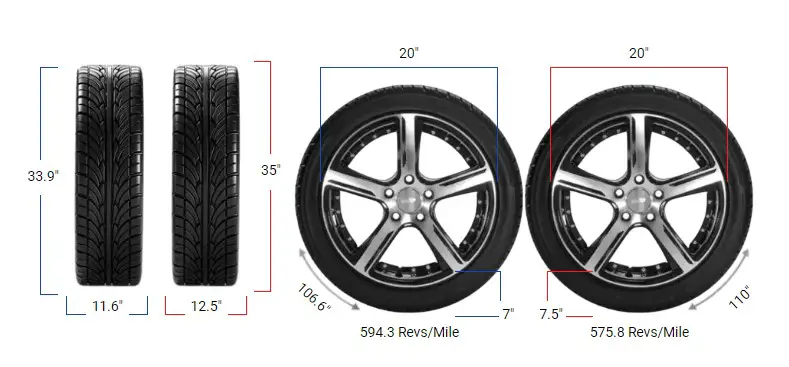
Changing your vehicle’s tire size can affect various aspects of its performance, from speedometer accuracy to ground clearance. When switching from 295/60R20 to 35×12.50R20 tires, it’s essential to understand the potential benefits and drawbacks to ensure a safe and enjoyable driving experience.
- The width of 35×12.50R20 tires is 7.8% larger than 295/60R20 tires.
- The speedometer will read 0.64 mph slower than the actual speed when using 35×12.50R20 tires.
- Ground clearance will increase by approximately 0.54 inches with 35×12.50R20 tires.
- The larger tire size may affect gas mileage and ride comfort.
295/60r20 vs 35×12.50r20 Table
The primary difference between 295/60R20 and 35×12.50R20 tires lies in their overall diameter, with the latter being 1.09 inches (27.6 mm) or 3.2% larger than the former.
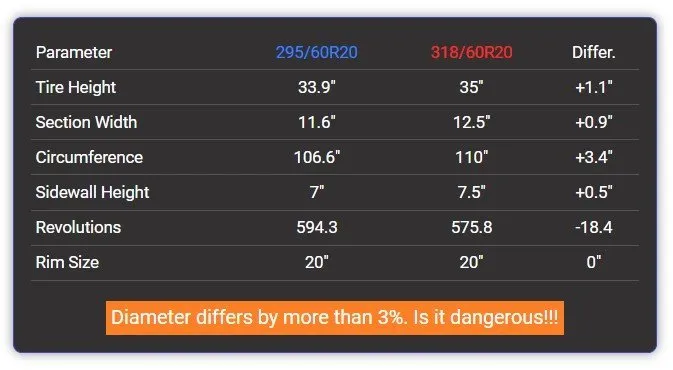
Fitment Guide
It’s essential to ensure that the diameter difference between the original and replacement tires falls within the acceptable range of 3%.
In this case, the 3.2% difference slightly exceeds the recommended limit, which may necessitate adaptations to prevent issues such as rubbing or clearance problems.
On-Road Impact
Switching from 295/60R20 to 35×12.50R20 tires can have various effects on your vehicle’s on-road performance. Let’s take a closer look at some key aspects:
- Speedometer Accuracy: Due to the larger overall diameter of 35×12.50R20 tires, your vehicle will experience a 3.1% reduction in revolutions per mile. This means that when your speedometer reads 20 mph (32.19 km/h), your actual speed will be 20.64 mph (33.22 km/h). While this difference may seem small, it’s important to be aware of it to ensure you’re driving within legal speed limits.
- Ride Comfort: The taller sidewall height of 35×12.50R20 tires (7.8% taller than 295/60R20) can potentially impact ride comfort. Taller sidewalls generally provide better cushioning against road imperfections, resulting in a smoother ride. However, the increased sidewall flexibility may also lead to reduced responsiveness and handling precision compared to the original tire size.
- Gas Mileage: The larger overall diameter and width of 35×12.50R20 tires may slightly impact your vehicle’s gas mileage. The increased rolling resistance and weight of the larger tires can lead to a minor reduction in fuel efficiency. However, the actual impact on gas mileage will depend on various factors, such as driving habits, vehicle type, and road conditions.
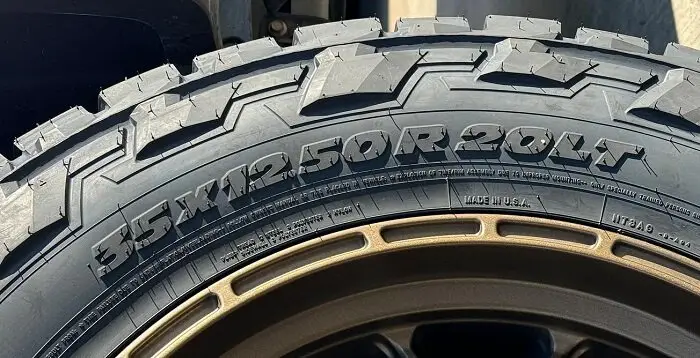
Off-Road Impact
If you frequently take your vehicle off-road, switching to 35×12.50R20 tires can offer several advantages:
- Ground Clearance: The taller sidewall height of 35×12.50R20 tires can increase your vehicle’s ground clearance by approximately 0.54 inches (13.8 mm). This extra clearance can be beneficial when navigating rough terrain, helping to reduce the risk of undercarriage damage from rocks, roots, and other obstacles.
- Traction: The wider tread width of 35×12.50R20 tires (0.91 inches or 23 mm wider than 295/60R20) can provide improved traction on loose surfaces like sand, mud, or gravel. The increased contact patch allows for better grip and stability, enhancing your vehicle’s off-road capabilities.
- Durability: Off-road tires, like the 35×12.50R20 size, are typically constructed with more robust materials and reinforced sidewalls to withstand the rigors of harsh terrains. This increased durability can help protect your tires from punctures, cuts, and other damage commonly encountered in off-road environments.
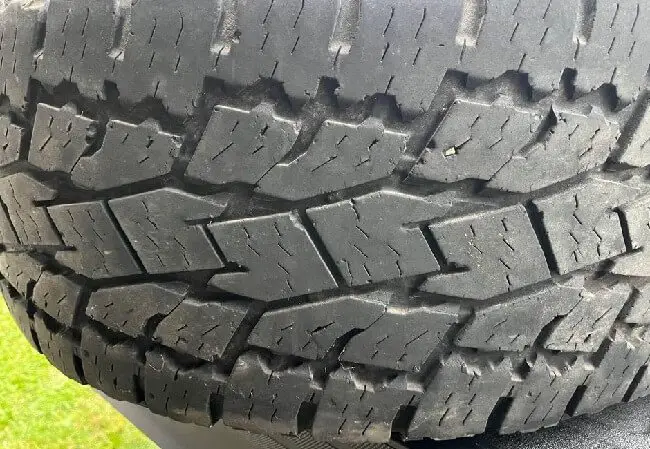
What is the Difference Between 295/60R20 and 35×12.5R20?
The main difference between the 295/60R20 and 35×12.5R20 tire sizes lies in their overall diameter. The 35×12.5R20 tire has a diameter of 35.02 inches (889.6 mm), which is 1.09 inches (27.6 mm) or 3.2% larger than the 295/60R20 tire.
This difference in diameter can affect various aspects of vehicle performance, such as speedometer accuracy, ground clearance, and overall handling.
Can I Use 35×12.5R20 Instead of 295/60R20?
It is generally not recommended to use 35×12.5R20 tires instead of 295/60R20 tires because the difference in their overall diameters exceeds the typically acceptable 3% range.
The 3.2% difference between these two tire sizes may necessitate vehicle modifications to ensure proper fitment and to avoid potential issues such as rubbing or clearance problems.
It is advisable to consult with a professional tire specialist or refer to your vehicle’s manufacturer recommendations before making any changes to your tire size.
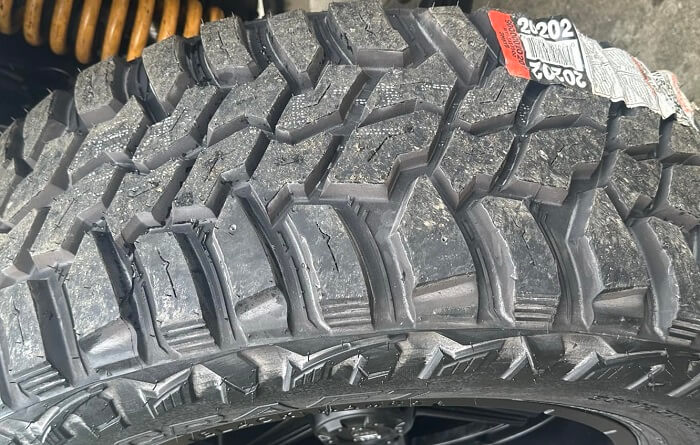
How Much Taller Is A 35×12.5R20 Tire Than A 295/60R20?
A 35×12.5R20 tire is approximately 1.09 inches (27.6 mm) taller than a 295/60R20 tire. This height difference is due to the larger overall diameter of the 35×12.5R20 tire, which stands at 35.02 inches (889.6 mm), compared to the 33.94 inches (862 mm) of the 295/60R20 tire.
How Much Wider is a 35×12.5R20 Tire Than a 295/60R20?
A 35×12.5R20 tire is 0.91 inches (23 mm) wider than a 295/60R20 tire. The width of the 35×12.5R20 tire is 12.52 inches (318 mm), while the width of the 295/60R20 tire is 11.61 inches (295 mm).
This difference in width is approximately 7.8% wider for the 35×12.5R20 tire compared to the 295/60R20 tire.
Our Observations
While switching from 295/60R20 to 35×12.50R20 tires offers some potential benefits, it’s crucial to consider the drawbacks as well. The 3.2% difference in overall diameter slightly exceeds the recommended ±3% range, which may require modifications to your vehicle to ensure proper fitment and clearance.
On-road, the taller sidewalls of 35×12.50R20 tires can enhance ride comfort but may slightly reduce handling responsiveness. The speedometer accuracy will also be affected, with the actual speed being slightly higher than indicated. Off-road, the increased ground clearance, wider tread width, and more durable construction of 35×12.50R20 tires can improve your vehicle’s performance on challenging terrains.
Ultimately, whether the differences between these tire sizes are significant or negligible depends on your specific driving needs and preferences. If you primarily drive on paved roads and prioritize precise handling, sticking with the original 295/60R20 tire size may be the best choice.
However, if you frequently venture off-road and want enhanced traction and durability, the benefits of switching to 35×12.50R20 tires may outweigh the minor on-road compromises.

Meet Caitlin McCormack, a Tire Size Expert and Blogger Passionate About Everything Related to Tires. With Years of Experience in the Tire Industry, Caitlin Has Become an Expert in Tire Sizes and Their Impact on Vehicle Performance.
